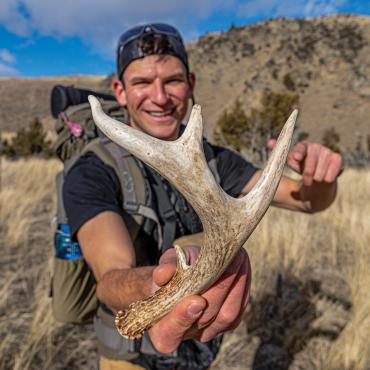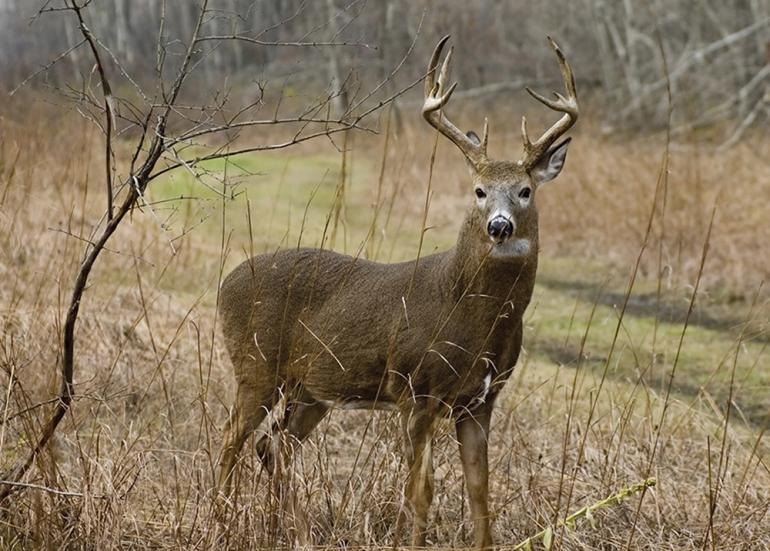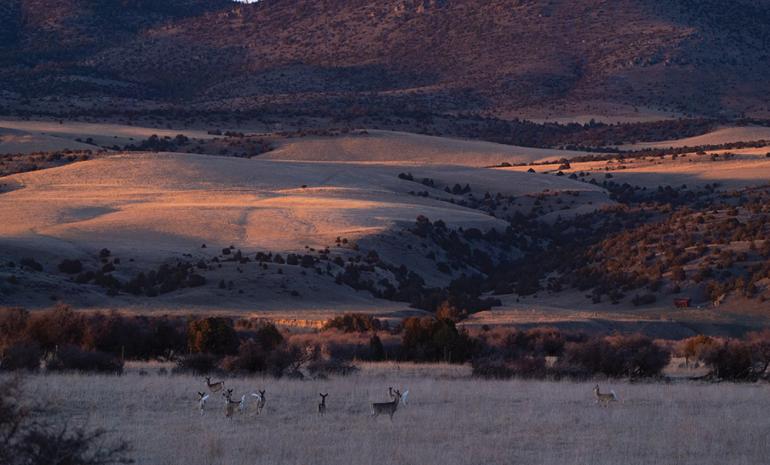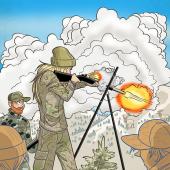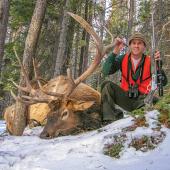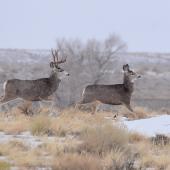Tighty Whiteys
Best practices to bring home a whitetail.
It was the last day of hunting season and the light was fading fast. But the setup was good, and with my rifle resting on a fencepost, aimed at the nearby treeline, an opportunity felt certain. Deer tracks from earlier in the day crisscrossed a layer of fresh snow, all converging on a single trail into the woods—in front of which I was now sitting. But the clock was ticking and there were no signs of life. Five minutes ’til the end of shooting light, my watch reported. Four minutes. Three minutes. Then, movement in the trees. Almost imperceptible, as though a single leaf had twitched but caught itself. Then another slight movement. Two minutes. Seemingly in slow motion, a deer appeared in the opening—a doe, followed by another. Moving like apparitions, they stayed close to the woods, working south toward a field. One minute. Another movement in the trees, and moments later a mature buck stood at the opening. One more step… it’s now or never. Bang!
Seemingly in slow motion, a deer appeared in the opening—a doe, followed by another. Moving like apparitions, they stayed close to the woods, working south toward a field.
Habitat
White-tailed deer have historically inhabited low-elevation farmland and river bottoms in southwest Montana, but their distribution is slowly increasing to include low- and mid-elevation foothills. Regardless, their favorite place to feed is on harvested farm fields, where they scavenge for corn and grain throughout hunting season. Often, whitetails will bed in the thickest, nastiest brush they can find close by. Hunters can take advantage of this by identifying travel routes and bedding areas, typically by looking for paths with trampled grass and deer droppings, or tracks and beds in fresh snow.
Bigger picture, whitetails are relatively stationary creatures, and an animal might live its whole life in the vicinity of a single farm field or section of land. Deer in the foothills might get pushed down by snow in winter, but they aren’t embarking on long, seasonal migrations like elk or mule deer. Finding areas with whitetails is rarely an issue, but successfully hunting them is a whole different story.
Behavior
Whiteys are notorious for being spooky—much more so that their muley cousins. It’s not uncommon to spot a white butt bounding away into the bushes before you see or hear anything else. These animals are also highly crepuscular, meaning most active at dusk and dawn, when they move between their thick, brambly bedding areas and open fields to feed. Anywhere with hunting pressure, they tend to become nocturnal, feeding all night and moving to and from their beds in darkness, avoiding exposure during legal shooting light altogether. However, they are creatures of habit, and they tend to use the same corridors day after day unless pressure forces them out.
Gear
Hunting these ghostly critters typically involves early mornings or long evenings of sitting, so plenty of warm clothes are essential. Good binoculars in sizes 10x42 or 10x50 that capture lots of light are useful for identifying deer at dusk and dawn as they sneak through the woods. Once an animal is on the ground, a knife is necessary for gutting and skinning. For hunting during the rut, a pair of old antlers can be used to rattle in bucks, and might be worth bringing along later in the season.
Bow vs. Rifle
Bow hunting for deer is challenging, and whitetails are no exception. Sneaking up on bedded animals is possible, but requires incredible patience and stealth. Alternatively, sitting in a transition area between bedding and feeding zones can be effective, but drawing a bow without being busted is nearly impossible. Thus, whitetail archers tend to sit in tree stands or set up temporary blinds from which to ambush deer.
Rifles provide a large advantage over pointy twigs when hunting whitetails. Transition-zone setups are a proven tactic, and a rifle’s extended range allows for more distance, and thus less risk of spooking the deer. During rifle season, get up early or stay out late. The first or last five minutes of legal shooting light are often the most productive. It’s not uncommon to see deer sprinting for cover as the light builds, or appearing out of the woods at the last few minutes of light. Set up on your backpack or a tripod ahead of time with shooting lanes identified, so you’re ready for the witching hour. Any rifle caliber from .243 up will work.
Pack-Out
Usually, packing out a whitetail simply involves dragging the animal back to your vehicle. One person can tow a doe or buck downhill or on flat ground, but going uphill might take two people. Alternatively, the pack-out could entail skinning and quartering the animal and hauling it out in a backpack. Two trips might be required for a larger buck.
Rut
The whitetail rut occurs in mid- to late November, and can result in some of the best hunting of the year. During the rut, it’s commonplace to see fully-grown bucks running around midday, noses pinned to game trails, sniffing for does. It’s the one time of year when bucks let their guard down. Leading up to the rut, bucks also become responsive to rattling antlers and come in to sniff out the competition and defend their turf and their does. Some years, the rut can go through the end of general season, giving hunters one last chance to get out over Thanksgiving to put some meat in the freezer.
Regs
In most units in southwest Montana, a general deer tag can be used on a whitetail buck or doe, though some districts may be buck-only. Additionally, doe tags are readily available for purchase over-the-counter in Region 3. In some units, with the right combination of tags, a hunter can harvest multiple does in a single season. As with all species and hunts, check the regulations for specifics. Also be mindful that it is illegal to discharge a firearm within a quarter-mile of occupied structures when hunting on state land, and that firearms must be discharged in a safe direction, regardless of the distance from houses or barns.
Eli Fournier is the former managing editor of Stalk, and an avid deer hunter come fall.

